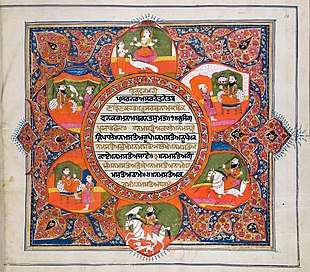Bachittar Natak
Bachittar Natak (or Bachitar/Bichittar) (ਬਚਿੱਤਰ ਨਾਟਕ, literally Resplendent Drama) is from Dasam Granth, ang (page) 94 to ang 175 of the 2326 ang. It is generally attributed to the tenth Sikh Guru, Guru Gobind Singh.
| Part of a series on |
| Dasam Granth |
|---|
 |
| Dasam Granth - (ਦਸਮ ਗ੍ਰੰਥ ਸਾਹਿਬ) |
| Banis |
|
| Other Related Banis |
|
| Various aspects |
| Idolatry Prohibition |
Although the word "Natak" means "drama" in Punjabi, this is no drama. The writer has outlined the circumstance and history of the time and how great courage and strength was required to overcome the many hurdles that were upon the community.
It starts with a praise of the God "Akal Purukh". It then gives a genealogy starting from King Surya, King Raghu, King Aja, King Dasrath to Lord Rama and his two sons Lav and Kush. It gives the author's own biography and includes the Battle of Nadaun, Husaini battle and the arrival of prince Muazzam in the Punjab. It continues up to AD 1696.
It is written in early Braj bhasha with some Apabhramsha influence. Several translations in Punjabi, Hindi and English exists.
The life's story of Guru Gobind Singh is further told by the court-poet Sainapat, who is also believed to have translated the Chanakya Niti at the Guru's behest. Sainapat finished his Sri Gur Sobha in AD 1711, three years after the death of the Guru. Other early sources are Koer Singh's Gurbilas Patshahi, written in 1751 and the Bansawalinamah by Kesar Singh Chhibbar (1767).
There is some controversy regarding the authorship (whether this was really written by Guru Gobind Singh) since some of the content and style does not match his hard line conservative views of some Sikh scholars Sikhism Guru Granth Sahib (refer to analysis in the external links section).
Outline of Bachittar Natak
Bichitra Natak (or Bachittar/Vichitra) (Gurmukhi ਬਚਿਤਰ ਨਾਟਕ (meaning Resplendent Drama)) is a composition, a memoir of Guru Gobind Singh, which he added in Dasam Granth, commonly known as his Brief Autobiography. It is a part of the Dasam Granth and is the name given to the third Bani in the second holy scriptures of the Sikhs. This text spans from page 94 to page 175 of the 2326 pages of this holy book of the Sikhs at www.srigranth.org. (Original text is over 1428 pages) This Bani is an autobiographical narrated by the tenth Sikh Guru, Guru Gobind Singh for the first 32 years of his life. Although the word "Natak" means "drama" in Punjabi, this is no drama. The writer has outlined the circumstance and history of the time and how great courage and strength was required to overcome the many hurdles that were upon the community. It starts with a praise of Akal Purakh. It then gives a genealogy of Bedis and Sodhis starting from Lord Rama and his two sons. It gives the author's own biography and includes the battle of Nadaun, Husaini battle and the arrival of prince Muazzam in the Punjab. It continues up to AD 1696. The chapters are numbered at the beginning, but the title of each chapter is given at the conclusion, following the traditional Indian convention.
- Chapter 1: Eulogy of Akal Purakh, the ultimate being.
- Chapter 2: My Story. Opening statements and mention of Lava and Kusha, the two sons of Rama.
- Chapter 3: Descendants of Lava and Kusha and emergence of the Bedi and Sodhi clans (in which 8 of the 10 Sikh Gurus were born).
- Chapter 4: The Recitation of the Vedas and the Offering of Kingdom. The interaction of the two clans.
- Chapter 5: Description of the Spiritual Rulers, i.e. of the nine Sikh Gurus preceding Gobind Singh himself, from Guru Nanak to Guru Teg Bahadur (father of Guru Gobind Singh).
- Chapter 6: The Command of Supreme Lord to Me be born into the World. Includes an account of Gobind Singh performing "tapa" at Hemkunt in the Himalayan mountains, in a previous birth.
- Chapter 7: Description of the Poet. Starts with his birth in Patna, and arrival in the Madra desh (i.e. Punjab region).
- Chapter 8: The Battle of Bhangani. Includes his settlement of the Anandpur sahib, which was to be the center of his spiritual and literary activities.
- Chapter 9: Description of the Battle of Nadaun.
- Chapter 10: Description of the Expedition of Khanzada and his flight.
- Chapter 11: Description of the fight with Hussaini and loss of his associates Kirpal, Himmat and Sangatia.
- Chapter 12: Description of the battle of Sahibjada Jujhar Singh ji.
- Chapter 13:Arrival of the Mughal Prince and his officers.
- Chapter 14: The Supplication to the Lord, Destroyer of All.
The autobiography terminate here abruptly. Apparently the Guru became engaged in other affairs. The next book in the Dasam Granth is Chandi Charitar. This composition is thought to have occurred just prior to the founding of the Khalsa order by the Guru.
Genealogy
The text contains Genealogy of Bedis and Sodhis among which Sikh Gurus were born. The genealogy traces back from King Surya. The Khalsa Tradition, as per Dasam Granth, is considered as part of this dynasty:[1]
- Surya (Suryavansha)
- Raghu, born in Suryavansha Dynasity, (Raghuvansha)
- Aja, son of Raghu
- Dasrath
- Rama, Laxman, Bharath and Shatrugan - All born to Dasrath
- Luva and Kusha - born to Rama.
- Many (Not named by Guru Gobind Singh to prevent scripture length)
- Kalket and KalRai
- Sodhi Rai, born to Kal Rai (Sodhivansha)
- Kalket (Bedi Vansha)
Guru Nanak born in Bedi Vansha and last 7 Gurus Born in Sodhisvansha. Guru Gobind Singh adopted Khalsa as Son of him and Mata Sahib Kaur, the reason Khalsa call itself from Sodhi Bansa.
References
- Bachitar Natak, Dasam Granth